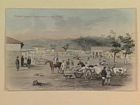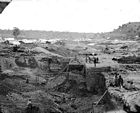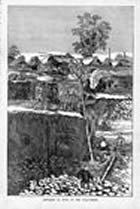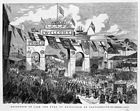The Chinese in central Victoria
During the middle of the nineteenth century the discovery of major gold reserves transformed the infant European settler societies of the Pacific Rim. These regions included the Sierra Nevada and Trinity Mountains of northern California, the Australian colony of Victoria and later the Caribou region of British Columbia, Canada and Central Otago in New Zealand.
Many of the international gold seekers of the 1850s and 1860s followed the goldrushes to Victoria. Chinese gold seekers, mostly from southern China, were key members of all these rushes. Today their legacy can been seen at the Gum Sam centre in Ararat, the Golden Dragon Museum in Bendigo (particularly Sun Loong the largest imperial dragon in the world), and at numerous Chinese market gardens and former campsites situated throughout the mining landscapes that make up the Castlemaine Diggings National Heritage Park. At Sovereign Hill you can also visit a faithful recreation of a Chinese village.
Following the introduction in Victoria of a poll-tax on the Chinese (this was a head tax that was paid upon landing) many of them landed at Guischen Bay near Robe in South Australia. It is still possible to retrace the overland route of the Chinese and follow their footsteps as they made their way towards Dai Gum San (or New Gold Mountain as central Victoria was more commonly known). The well-travelled routes to the mining areas of Ballarat, Bendigo and Mount Alexander would have been the final and most arduous part of this journey but the Mount Alexander diggings were the greatest shallow alluvial gold diggings the world had known. The scale of the rushes and the potential of winning gold there had triggered a global mass movement of people to Australia. Among them the Chinese gold seekers were the largest group of non-English speaking diggers on the Australian goldfields.
This story of the goldfields Chinese begins in the Pearl River Delta region of southern China. Throughout three and a half centuries, from the arrival of the Portuguese at Macau in 1498 to the outbreak of the first Opium War in 1840, this core area witnessed the transition of Sino-Western relations from an era of peaceful trade to one of direct confrontation between Britain and China.
Conflict in Southern China meant that many people from the region moved to areas throughout the south-west Pacific including the British settler colonies of New South Wales and Victoria in search of gold. The greatest numbers of Chinese came to the colony of Victoria from 1852 onwards. It was a place that only two years earlier had been regarded as a provincial backwater of the British Empire and its very existence had been called into question following the environmental devastation wrought by the 1850 bushfires that spanned every region of the colony. By the mid-1850s, however, it had become renowned throughout the world for its fabulous alluvial gold wealth.
The Chinese, who at one stage during the late 1850s accounted for one in 10 Victorians, settled in the key goldfields centres of Bendigo, Ballarat and Castlemaine. They brought with them their distinctive way of life and specialised mining techniques. Some encountered hostility and racist attitudes but as a group the Chinese were renowned for their industry. It is only recently that the full extent of the Chinese role in the emergent central Victorian goldfields society is coming to light.
Although best known for their role in the gold mining industry they were involved in many other pursuits on the goldfields. Many worked as herbalists, merchants, and restaurateurs. Others played an important role in the development of the region by working as market gardeners and continued to do so well into the twentieth century. Today the remnants of their market gardens can be seen in the southern reaches of the Castlemaine Diggings National Heritage Park situated in and around Vaughan and Glenluce. One subtle legacy of their market gardens visible in the present day is the wild spring onions that occasionally appear along the Loddon River.
We can link these goldfields landscapes with the stories of the Chinese diggers who came to Australia from China, often via California, to take part in the great rushes. Lee Heng Jacjung, for example, was a seasoned member of the gold seeking generation, a ‘forty niner’ in California before he sailed to Sydney and promptly headed to Victoria when news of the gold finds in Ballarat, and soon after at Mount Alexander, became known. He was equipped with knowledge of gold seeking, had good connections with the Chinese fraternal organisations that regulated and coordinated much of Chinese life in the new worlds and possessed excellent bilingual skills. Like so many of the Chinese gold seekers Lee Heng was part of the broader movement of people who arrived in the central Victorian region in search of gold, independence and prosperity.
Soon after his arrival in Victoria, Lee Heng settled on the Fryers Creek diggings, situated five kilometres south of present day Castlemaine, where he acted as an official interpreter at the local court. He met a young woman, Katherine Hornick, whom he subsequently married and shortly afterwards they made a home together at the tiny hamlet of Vaughan in the southern region of the Mount Alexander diggings. Here the family became integral members of the local community.
Even today new evidence of the Chinese presence on the Victorian goldfields continues to be uncovered. The recent archaeological dig at Bendigo has unearthed one of the largest Chinese industrial kilns to be found outside China. The artefacts that have been recovered, like the mining landscapes of the goldfields regions, offer glimpses into the past that reveal the history of the Chinese in central Victoria from the goldrush era until the twentieth century.

.jpg)







